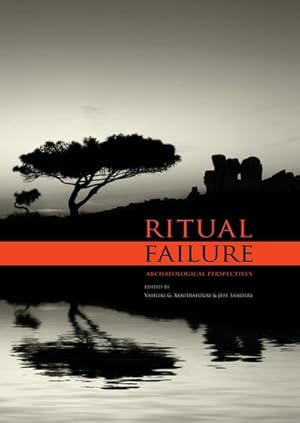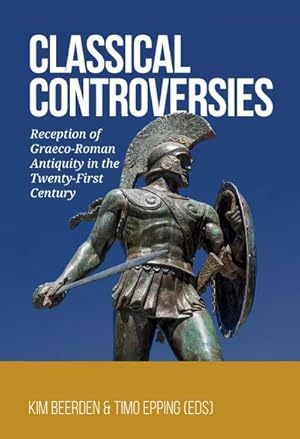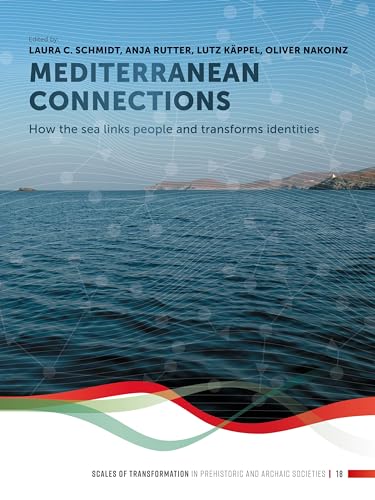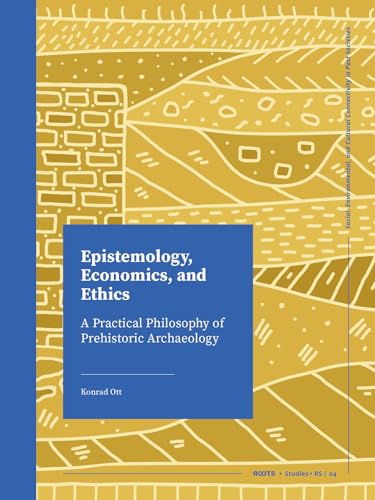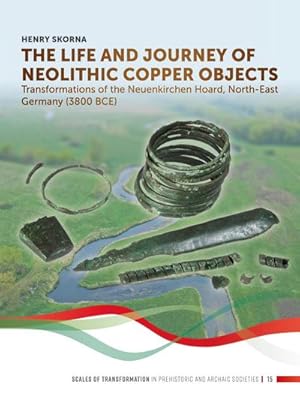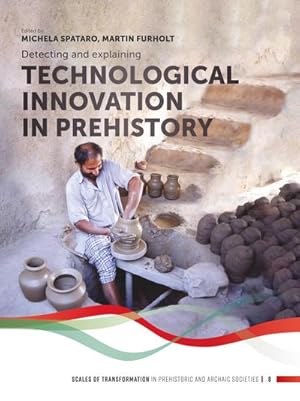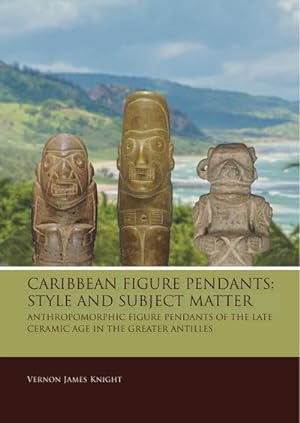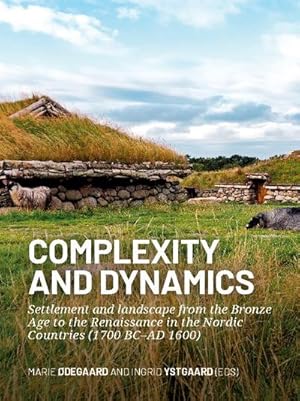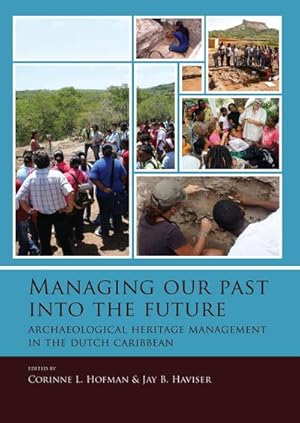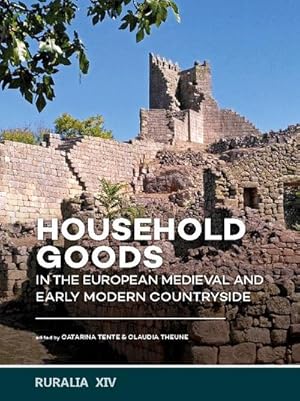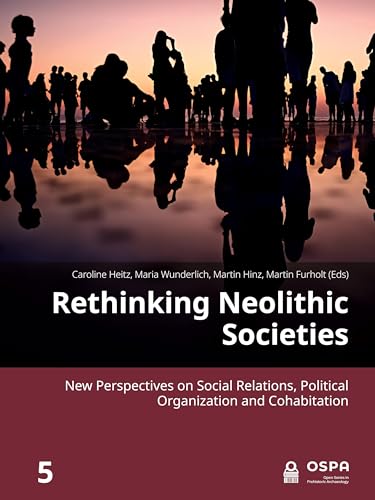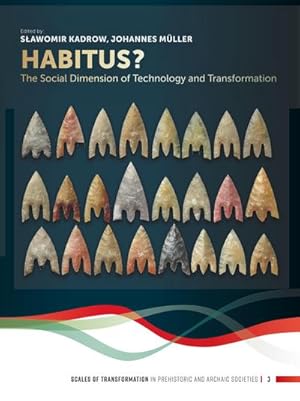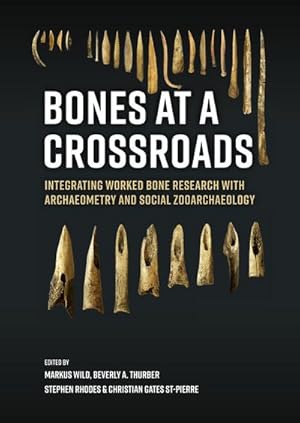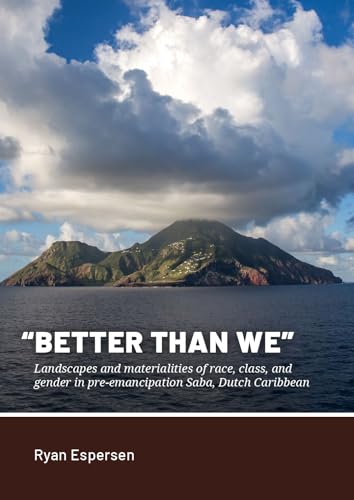sidestone press sidestone press academics (348 risultati)
Tipo di articolo
- Tutti gli articoli
- Libri (348)
- Riviste e Giornali
- Fumetti
- Spartiti
- Arte, Stampe e Poster
- Fotografie
- Mappe
-
Manoscritti e
Collezionismo cartaceo
Condizioni
Legatura
Ulteriori caratteristiche
- Prima edizione (70)
- Copia autografata
- Sovraccoperta
- Con foto (334)
- No print on demand (78)
Paese del venditore
Valutazione venditore
-
Ritual Failure
Editore: Sidestone Press Academics Dez 2013, 2013
ISBN 10: 9088902208ISBN 13: 9789088902208
Da: BuchWeltWeit Ludwig Meier e.K., Bergisch Gladbach, Germania
Libro Print on Demand
Taschenbuch. Condizione: Neu. This item is printed on demand - it takes 3-4 days longer - Neuware -'Ritual Failure' is a new concept in archaeology adopted from the discipline of anthropology. Resilient religious systems disappearing, strict believers and faithful practitioners not performing their rites, entire societies changing their customs: how does a religious ritual system transform, change or disappear, leaving only traces of its past glory Do societies change and then their ritual Or do customs change first, in turn provoking wider cultural shifts in society Archaeology possesses the tools and methodologies to explore these questions over the long term; from the emergence of a system, to its peak, and then its decay and disappearance, and in relation to wider social and chronological developments. The collected papers in this book introduce the concept of 'ritual failure' to archaeology. The analysis explores ways in which ritual may have been instrumental in sustaining cultural continuity during demanding social conditions, or how its functionality might have failed - resulting in discontinuity, change or collapse. The collected papers draw attention to those turbulent social times of change for which ritual practices are a sensitive indicator within the archaeological record. The book reviews archaeological evidence and theoretical approaches, and suggests models which could explain socio-cultural change through ritual failure. The concept of 'ritual failure' is also often used to better understand other themes, such as identity and wider social, economic and political transformations, shedding light on the social conditions that forced or introduced change. This book will engage those interested in ritual theory and practices, but will also appeal to those interested in exploring new avenues to understanding cultural change. From transformations in the use of ritual objects to the risks inherent in practicing ritual, from ritual continuity in customs to sudden and profound change, from the Neolithic Near East to Roman Europe and Iron Age Africa, this book explores what happens when ritual fails.Contents:IntroductionVasiliki G. Koutrafouri and Jeff SandersForeword: Introductory Thoughts on the Theme of 'Ritual Failure. Archaeological Perspectives'.by Timothy InsollThe Passage of Matter: Transformations of Objects and Ritual Meanings in the Neolithic of the Near East.Marc VerhoevenThe sky almost never falls on your head - why ritual rarely fails Jeff SandersRitual Failure in the Business Records of Mesopotamian TemplesMichael KozuhRitual Failure and the Temple collapse of prehistoric Malta.Caroline Malone and Simon StoddartFrom wells to pillars, and from pillars to. Ritual systems transformation and collapse in the early prehistory of CyprusVasiliki G. KoutrafouriWhen Ancestors become Gods: The Transformation of Cypriote Ritual and Religion in the Late Bronze AgeDavid CollardColonial Entanglements and Cultic Heterogeneity on Rome's Germanic FrontierKarim MataThe Dead Acrobat: Managing Risk and Minoan IconographyEvangelos KyriakidisDiscussion: Defining momentsby Richard Bradley 170 pp. Englisch.
Ulteriori offerte da altri venditori AbeBooks
Nuovo - A partire da EUR 30,00
-
Bridging Social and Geographical Space through Networks
Editore: Sidestone Press Academics Apr 2021, 2021
ISBN 10: 9464270004ISBN 13: 9789464270006
Da: BuchWeltWeit Ludwig Meier e.K., Bergisch Gladbach, Germania
Libro Print on Demand
Taschenbuch. Condizione: Neu. This item is printed on demand - it takes 3-4 days longer - Neuware -This volume represents a bold attempt by the editors to bring scholars from distinct research orientations together, to discuss the interplay between the geographic and social dimensions of different kinds of interaction networks.Within the humanities, networks afford an umbrella of approaches to the study of social relations and their patterning, both through qualitative and quantitative applications, with two main perspectives standing out: those centered on space and those concerned with the social dimension of interaction. In this book, we aim to highlight the potential for integrating these different research directions and identify common ground for developing new interdisciplinary insights.The volume demonstrates how a network approach can successfully incorporate and frame different kinds of theoretical perspectives and methodological applications, drawing on multiple strands of social and geographical theory and using data as diverse as archaeological artefacts, roads/infrastructure, textual sources, and information from living informants. As such, it will appeal to archaeologists, historians, geographers, and sociologists, as well as anyone interested in exploring further the potential for employing network-based methodologies within the Humanities and Social Sciences, and in enriching their understanding of the theoretical and interdisciplinary underpinnings of widely employed concepts in network science.The volume stems from a workshop held at the Freie Universität Berlin which was funded and hosted by the Excellence Cluster Topoi. The publication of the proceedings has been made possible thanks to generous financial support from the Gerda Henkel Foundation.ContentsBridging social and geographical space through networks: IntroductionH. Dawson and F. IaconoThree simple geographical network models for the Holocene Bismarck SeaM. Golitko and J.E. TerrellTerrestrial transportation networks and power balance in Etruria and Latium Vetus between the beginning of the Early Iron Age and the end of the Archaic PeriodF. Fulminante, S. Lozano, L. Prignano, and I. MorerGetting around the City: A Space Syntax perspective on post-medieval NurembergD. WehnerMemory as a network of affects: bridging the humanities and social sciences to understand the social spaces of storytellingS. De NardiAt the heart of Mare Nostrum: Islands and 'small world networks' in the central Mediterranean Bronze AgeH. DawsonMarx, networks and the social logic of interactionF. Iacono 130 pp. Englisch.
Ulteriori offerte da altri venditori AbeBooks
Nuovo - A partire da EUR 30,00
-
Environmental humanities: a rethinking of landscape archaeology?
Editore: Sidestone Press Academics Apr 2021, 2021
ISBN 10: 9464270039ISBN 13: 9789464270037
Da: BuchWeltWeit Ludwig Meier e.K., Bergisch Gladbach, Germania
Libro Print on Demand
Taschenbuch. Condizione: Neu. This item is printed on demand - it takes 3-4 days longer - Neuware -There has been an increasing archaeological interest in human-animal-nature relations, where archaeology has shifted from a focus on deciphering meaning, or understanding symbols and the social construction of the landscape to an acknowledgement of how things, places and the environment contribute with their own agencies to the shaping of relations.This means that the environment cannot be regarded as a blank space that landscape meaning is projected onto. Parallel to this, the field of environmental humanities poses the question of how to work with the intermeshing of humans and their surroundings.To allow the environment back in as an active agent of change, means that landscape archaeology can deal better with issues such as global warming, an escalating loss of biodiversity as well as increasingly toxic environment. However, this does not leave human agency out of the equation. It is humans who reinforce the environmental challenges of today.The scholarly field of the humanities deal with questions like how is meaning attributed, what cultural factors drive human action, what role is played by ethics, how is landscape experienced emotionally, as well as how concepts derived from art, literature, and history function in such processes of meaning attribution and other cultural processes. This humanities approach is of outmost importance when dealing with climate and environmental challenges ahead and we need a new landscape archaeology that meets these challenges, but also that meets well across disciplinary boundaries. Here inspiration can be found in discussions with scholars in the emerging field of Environmental Humanities.ContentsEnvironmental humanities a rethinking of landscape archaeology Sjoerd Kluiving, Kerstin Lidén, Christina FredengrenNature and society: an integrated multi-perspective landscape approach in practiceOscar JacobssonTravel books as landscape archaeology reports: from history to ecological responsibility: The Example of British and American Travellers in the PyreneesFrancoise BessonFragments of the Wild: Wordsworth's Yew Trees and Contemporary ArchaeologyAndrew HoaenGeological and historical findings reveal differential anthropogenic substrate control in unique streets of Diemen, The NetherlandsRonald van Gelder, Sjoerd Kluiving, Inger Leemans, Ruben den Ouden, Jan GoedhartRe-thinking Deep Time LandscapesChristina Fredengren 108 pp. Englisch.
Ulteriori offerte da altri venditori AbeBooks
Nuovo - A partire da EUR 30,00
-
Classical Controversies
Editore: Sidestone Press Academics Nov 2022, 2022
ISBN 10: 9464270365ISBN 13: 9789464270365
Da: BuchWeltWeit Ludwig Meier e.K., Bergisch Gladbach, Germania
Libro Print on Demand
Taschenbuch. Condizione: Neu. This item is printed on demand - it takes 3-4 days longer - Neuware -Modern receptions of Graeco-Roman Antiquity are important ideological markers of the ways we envisage our own twenty-first-century societies. An urgent topic of study is: what kinds of narratives - sometimes controversial - about Antiquity do people create for themselves at this moment in time, and for what reasons This volume aims to showcase a number of illustrative examples, and thus to provide a deeper understanding of twenty-first-century reception of Antiquity.After a general introduction in Part I, the volume focuses on two main fields: controversies referencing ancient and modern literary works; and controversies surrounding heritage ethics.Part II takes literary evidence from the USA to Italy as its starting point: it shows how metaphors about early Christianity find their way into American conservative discourse; how Sparta is evoked in right-wing thinking in the USA, Germany, France and Scandinavia; and how Aeneas plays a role in recent Italian debates on migrations. The last paper discusses the depiction of classicists in modern novels.Part III focuses on heritage ethics and material culture, in first instance taking practices at the Dutch National Museum of Antiquities (Rijksmuseum van Oudheden) - on the display of death, queering and orientalism - as case studies. The last paper delves into the history of the Via Belgica to show how antiquity has been weaponised for political aims for many centuries.Together, these papers show that academics should engage with the receptions of antiquity in the recent past and present. If they want their research and museum displays to be part of current reception, they should make their voice heard.About the EditorsKim Beerden is a lecturer in Ancient History at Leiden University, The Netherlands. She has published in the field of ancient divination, see her monograph Worlds full of signs: ancient Greek divination in context (Brill, Leiden: 2013; paperback 2021).Timo Epping is a museum educator at the National Museum of Antiquities (Leiden, The Netherlands). He has published several articles in journals for history teachers and museum education.ContentsPart I: IntroductionPrefaceKim Beerden1. Introduction: Stop the Steal!Frederick G. NaereboutPart II: Controversies and Literary Traditions2. Whose persecution Early Christianity as a Metaphor in Contemporary American Political DiscourseK.P.S. (Renske) Janssen3. Spartans on the Capitol: Recent Far-Right Appropriations of Spartan Militarism in the USA and their Historical RootsStephen Hodkinson4. Leonidas Goes North: Swedish Appropriations of Sparta and the Battle of Thermopylae and their Wider European ContextJohannes Siapkas and Thomas Sjösvärd5. Pop Culture against Modernity: New Right-Wing Movements and the Reception of SpartaJulia Müller6. Fato Profugus. Aeneas the Refugee: an Italian DebateMarco Gay7. The Classicist as a Literary Character in Contemporary Literature: the Depiction of a DisciplineBarbara HollerPart III: Controversies and Heritage Ethics8. Ancient Death and the Contemporary World: the Role of Graeco-Roman Death in Museum DisplayPatricia Kret9. Queering the National Museum of AntiquitiesSuus van den Berg10. Dummie de Mummie: an Egyptian Body as the Undead, Oriental OtherDaniel Soliman11. Who Owns the Road to the Roman Past The Case of the Via Vipsania aka the chaussée romaine, the Römerstrasse, the Romeinse kassei, aka the Via BelgicaLiesbeth Claes 234 pp. Englisch.
Ulteriori offerte da altri venditori AbeBooks
Nuovo - A partire da EUR 35,00
-
Unhinging the National Framework
Editore: Sidestone Press Academics Dez 2020, 2020
ISBN 10: 9088909741ISBN 13: 9789088909740
Da: BuchWeltWeit Ludwig Meier e.K., Bergisch Gladbach, Germania
Libro Print on Demand
Taschenbuch. Condizione: Neu. This item is printed on demand - it takes 3-4 days longer - Neuware -This book focuses on the 20th century lives of men and women whose life-work and life experiences transgressed and surpassed the national boundaries that existed or emerged in the 20th century. The chapters explore how these life-stories add innovative transnational perspectives to the entangled histories of the world wars, decolonization, the Cold War and post-colonialism.The subjects vary from artists, intellectuals, and politicians to ordinary citizens, each with their own unique set of experiences, interactions and interpretations. They trace the building of socio-cultural and professional networks, the casual encounters of everyday life, and the travel, translation, and preserving of life stories in different media. In these multiple ways the book makes a strong case for reclaiming lost personal narratives that have been passed over by more orthodox nation-state focused approaches.These explorations make use of social and historical categories such as class, gender, religion and race in a transnational context, arguing that the transnational characteristics of these categories overflow the nation-state frame. In this way they can be used to 'unhinge' the primarily national context of history-writing.By drawing on personal records and other primary sources, the chapters in this book release many layers of subjectivity otherwise lost, enabling a richer understanding of how individuals move through, interact with and are affected by the major events of their time.ContentsIntroductionBabs Boter and Marleen RensenArchival tracesMieke Bouman (1907-1966) and the Jungschläger/Schmidt trialsErnestine HoegenColonialism, class, and collaboration: A wartime encounter on JavaEveline Buchheim'The Voortrekkers, on their way to Pretoria, 1952': Doing Race in Life Writing from South Africa to the NetherlandsBarbara HenkesNetworkingSleepwalking to a poem: A theory of Adrienne Rich's translations from the DutchDiederik OostdijkW.E.B. Du Bois at Ons Suriname: Amsterdam transnational networks and Dutch anti-colonial activism in the late 1950sLonneke GeerlingsFollowing the letters: Emile de Laveleye's transnational correspondence networkThomas D'haeninckCirculationBooker T. Washington's Up From Slavery in the Dutch Empire, 1902-1995Marijke HuismanThe production and contestation of biography: New approaches from South AfricaCiraj RassoolOrdinary lives: teaching history with life narratives in transnational perspectiveNancy MykoffStarring Morgenland! The life and work of Jan Johannes Theodorus Boon (1911-1974)Edy SeriesePositionings'She is English, isn't she ': transnationality as part of Cissy van Marxveldt's self-presentationMonica Soeting'A caveman in a canal house': The rejection of transnationalist biography in Hafid Bouazza's A Bear in Fur CoatSjoerd-Jeroen MoenandarAfterword: Reflections from a diplomatic historianGiles Scott-Smith 212 pp. Englisch.
Ulteriori offerte da altri venditori AbeBooks
Nuovo - A partire da EUR 35,00
-
Debating Religious Space and Place in the Early Medieval World (c. AD 300-1000)
Editore: Sidestone Press Academics Mai 2018, 2018
ISBN 10: 9088904189ISBN 13: 9789088904189
Da: BuchWeltWeit Ludwig Meier e.K., Bergisch Gladbach, Germania
Libro Print on Demand
Taschenbuch. Condizione: Neu. This item is printed on demand - it takes 3-4 days longer - Neuware -Religious spaces are often some of the most debated, contested, or otherwise scrutinized in the early medieval world. That space and place were important to people in the past is evident in their architecture, artwork, literature, and in their cemeteries and burial grounds. While these observations are not new, this volume brings together interdisciplinary and multi-national archaeologists, historians, and geographers to discuss and debate 'space' and 'place' with a focus on new methodologies and current approaches to Late Antiquity and the Early Middle Ages. The papers in this volume address such themes as phenomenological and experiential issues in the archaeology of space and place; access to and visibility of spaces (locations) in the past; the transformation and appropriation of spaces beyond the 'Christian/Pagan' dichotomy; and aspects of community and memory building in the medieval world. The contributors to this volume recognize that terms such as 'Christianisation', 'Islamisation', and indeed 'space' and 'place' themselves are loaded words and each paper takes a different route to the discussion of sacred space in the past. Together, they offer a current discussion about the role of 'space' and 'place' in religious history.ContentsIntroduction: Defining Religious 'Space' and 'Place' Brittany Thomas and Chantal BielmannChapter 1. The Evolution of Forum Space in Late Antique Hispania: the Genesis of a New Urbanism Pilar Diarte-BlascoChapter 2. Malta in Late Antiquity: Mortuary Places and SpacesGlen FarrugiaChapter 3. A Case for Space: Rereading the Imperial Panels of San VitaleBrittany ThomasChapter 4. The Early Medieval architecture of the cult places in the Western Alps: The Verbano Cusio Ossola districtFrancesca GaranziniChapter 5. Identifying the Anglo-Saxon Cemeteries in the Tees Valley, North-East EnglandStephen J. SherlockChapter 6. Religious Change vs Cultural Change: The Case of Islamisation in the Early Medieval PeriodJose Carvajal LopezChapter 7. Interactions between the Clerical Enclosure and the Extra-Claustral Clergy in Carolingian Francia: A Sacred Space with Porous Walls Stephen LingChapter 8. The monastery of Saint Maurice of Agaune (Switzerland) in the first millenniumAlessandra Antonini (translated by Chantal Bielmann)Chapter 9. Exploring Monastic Space and Place in the Swiss AlpsChantal BielmannChapter 10. Sacred Ground: Community and Separation in a Norse Churchyard, GreenlandJess Angus McCulloughChapter 11. Light and Life in the Catacombs: Questioning the Early Christian and Early Medieval Pilgrim ExperienceNeil ChristieConclusion: Looking for Beliefs and Visions in ArchaeologyDeirdre O'Sullivan 218 pp. Englisch.
Ulteriori offerte da altri venditori AbeBooks
Nuovo - A partire da EUR 40,00
-
Connectivity Matters!
Editore: Sidestone Press Academics Jan 2023, 2023
ISBN 10: 9464270276ISBN 13: 9789464270273
Da: BuchWeltWeit Ludwig Meier e.K., Bergisch Gladbach, Germania
Libro Print on Demand
Taschenbuch. Condizione: Neu. This item is printed on demand - it takes 3-4 days longer - Neuware -This book is a presentation of the basic concept of social, environmental and cultural connectivity in past societies, as embodied in a diversity of disciplines in the Cluster of Excellence ROOTS. Thus, rather pragmatically driven ideas of socio-environmental connectivities are described, which form the basis of the Cluster of Excellence in its research.A discussion of the fluidness of the term 'connectivity' and the applicability of the concept opens the arena for diverse interpretations. With various case and concept studies, the reader may advance into the perspectives that develop from the new interdisciplinary interaction. These include both rarely considered dependencies between nomadic and urban lifestyles, and aspects of water supply and water features, which represent an area of connectivity between the environment and agglomerated human settlement structures. Moreover, diachronic aspects are presented in various studies on the role of connectivities in the development of social inequality, the use of fortification or also waste behaviour, and the creation of linguistic features in written media.In sum, facets of connectivity research are revealed that are also being investigated in numerous other disciplines with further results in the Kiel Excellence Cluster ROOTS.ContentsPreface of the series editorsLutz Käppel, Johannes Müller, Wolfgang RabbelPreface of the volume editorJohannes MüllerIntroductionSocial, environmental, and cultural connectivity: A concept for an understanding of society and the environmentJohannes Müller, Lutz Käppel, Andrea Ricci, Mara WeineltOn the concept of connectivityV.P.J. ArponenNodes of connectivity: The role of religion in the constitution of urban sites in nomadic Inner AsiaJonathan Ethier, Christian Ressel, Birte Ahrens, Enkhtuul Chadrabaal, Sampildonov Chuluun, Martin Oczipka, Henny PiezonkaWater supply, settlement organisation and social connectivityAnnette Haug and Ulrich MüllerAn archaeological perspective on social structure, connectivity and the measurements of social inequalityTim Kerig, Johannes Bröcker ( ), René Ohlrau, Tanja Schreiber, Henry Skorna, Fynn WilkesConnectivity and fortificationsOliver Nakoinz, Anna K. Loy, Christoph Rinne, Jutta Kneisel, Tanja Schreiber, Maria Wunderlich, Nicole TaylorConnecting linguistics and archaeology in the study of identity: A first explorationJohn Peterson, Nicole Taylor, Ilja A. Serzant, Henny Piezonka, Ariba Hidayet Khan, Norbert NüblerThe dimensions of refuse: Discard studies as a matter of connectivityJens SchneeweißIdeology and identity in grammar: A diachronic-quantitative approach to language standardisation processes in Ancient GreekIlja A. Serzant and Dariya Rafiyenko 212 pp. Englisch.
Ulteriori offerte da altri venditori AbeBooks
Nuovo - A partire da EUR 40,00
-
Variant scholarship
Editore: Sidestone Press Academics Apr 2023, 2023
ISBN 10: 9464270454ISBN 13: 9789464270457
Da: BuchWeltWeit Ludwig Meier e.K., Bergisch Gladbach, Germania
Libro Print on Demand
Taschenbuch. Condizione: Neu. This item is printed on demand - it takes 3-4 days longer - Neuware -Since the eighteenth century, many if not most ancient and medieval manuscripts or other text-bearing or associated objects have been procured through imperial expropriation or through the antiquities market with little or no evidence of findspot or place of original deposition and with no assurance of legal provenance or authenticity. The consequences of these questionable acquisition practices for scholarship and for our understanding of the past are the focus of much enquiry.Recent high-profile acquisitions (and subsequent returns) of text-bearing objects by prominent private collectors and museums and the appearance on the market of demonstrably modern forgeries have resulted in increased scrutiny of the intellectual and commercial impacts of academic engagement. Scholarly research can abet the antiquities market directly or indirectly through identification, authentication and legitimation of illegally traded text-bearing objects.These harmful complications of well-established academic practice raise important questions about how and even if the academy should engage with ancient texts and text-bearing objects of uncertain provenance. Through a wide-ranging set of case studies, Variant Scholarship focuses on the methodological, theoretical, and ethical dilemmas facing scholars when working with ancient texts in modern contexts.This book is intended for those interested in the historical practices of research into ancient manuscripts, ethical quandaries in studying unprovenanced textual materials, and the unintended consequences of scholarly interactions with problematic text-bearing objects.ContentsVariant scholarship: ancient texts in modern contextsNeil Brodie, Morag M. Kersel, and Josephine Munch RasmussenDisciplinary pitfalls: how good philology can mask bad provenanceNils H. KorsvollThe provenance of the Dead Sea Scrolls: five examplesÅrstein JustnesPerforming papyrology: cartonnage, discovery and provenanceRoberta MazzaThe Ilves Collection: a Finnish manuscript collector and the academic facilitatorsRick BonnieNoxious scholarship The study and publication of First Sealand Dynasty cuneiform tabletsNeil BrodieConsuming PalmyraMichael PressEthical guidelines for publishing ancient textsPatty GerstenblithThe trouble with textsMorag M. KerselThe value of forgeries for historical researchChrista Wirth and Josephine M. RasmussenSomeone else's manuscripts: the ethics of textual scholarshipLiv Ingeborg LiedBetween representation and the real: the forgeries of Constantine SimonidesRachel Yuen-CollingridgeProvenance: genocide. The transfer of Armenian sacred objects to art collectionsHeghnar Zeitlian WatenpaughDigitizing manuscripts and the politics of extractionRaha Rafii 250 pp. Englisch.
Ulteriori offerte da altri venditori AbeBooks
Nuovo - A partire da EUR 40,00
-
Mediterranean Connections
Editore: Sidestone Press Academics Dez 2023, 2023
ISBN 10: 9464270691ISBN 13: 9789464270693
Da: BuchWeltWeit Ludwig Meier e.K., Bergisch Gladbach, Germania
Libro Print on Demand
Taschenbuch. Condizione: Neu. This item is printed on demand - it takes 3-4 days longer - Neuware 236 pp. Englisch.
Ulteriori offerte da altri venditori AbeBooks
Nuovo - A partire da EUR 40,00
-
Epistemology, Economics, and Ethics
Editore: Sidestone Press Academics Dez 2023, 2023
ISBN 10: 9464270810ISBN 13: 9789464270815
Da: BuchWeltWeit Ludwig Meier e.K., Bergisch Gladbach, Germania
Libro Print on Demand
Taschenbuch. Condizione: Neu. This item is printed on demand - it takes 3-4 days longer - Neuware 256 pp. Englisch.
Ulteriori offerte da altri venditori AbeBooks
Nuovo - A partire da EUR 40,00
-
The Life and Journey of Neolithic Copper Objects
Editore: Sidestone Press Academics Nov 2022, 2022
ISBN 10: 9464270306ISBN 13: 9789464270303
Da: BuchWeltWeit Ludwig Meier e.K., Bergisch Gladbach, Germania
Libro Print on Demand
Taschenbuch. Condizione: Neu. This item is printed on demand - it takes 3-4 days longer - Neuware -This work is an intensive study of the Neolithic deposition of copper objects from Neuenkirchen in North-East Germany. This unique ensemble represents one of the very rare hoard finds from the early Early Neolithic, and is the first of its kind for nearly 100 years, matched only by the famous younger hoard find from Bygholm (Denmark).The beginning of neolithization at the end of the fifth millennium is not only characterised by a change in the subsistence strategy, but also by the development of far-reaching networks of the Neolithic Funnel Beaker societies in Northern Germany. Proof is provided by the first metal finds which also appear at the same time in the North and were imported from the early metallurgical centres in the Balkan-Carpathian area. The hoard of Neuenkirchen is an outstanding example for these new, long-distance contacts.Drawing from a multi-method approach, the study attempts to trace the life and journey of the individual objects in the hoard and the transformation processes they underwent before they finally ended up in the ground. To this end, an intensive typological discussion, use-wear analysis, plus trace element and lead isotopes analyses of the objects are paired with a comprehensive overview of the natural environment, deposition practices, and settlement activities in the vicinity of Neuenkirchen. In the context of comparable hoard finds from the 5th/4th millennium, and the development of early metallurgy in Southeast Europe, these results make the journey and transformation of the objects from Neuenkirchen comprehensible.Contents1. Introduction2. Topographical posistion of Neuenkirchen3. State of research on the Funnel Beaker North Group in present-day Mecklenburg-Western Pomerania4. Chronology of the Funnel Beaker Societies5. Anthropogenic activities in the surroundings of Neuenkirchen at the time of the Funnel Beaker Societies6. Finds and features of the hoard find from Neuenkirchen7. Analysis of traces of manufacture and use8. X-ray flurorescence and lead isotopes analyses9. Early Copper in Mecklenburg-Western Pomerania10. Typo-chronological analyses of the Neuenkirchen artefacts11. Neuenkirchen in the mirror of the development of Early Metallurgy in Southeast Europe12. Neuenkirchen - profane, ritual and/or social practice 13. Summary14. References 200 pp. Englisch.
Ulteriori offerte da altri venditori AbeBooks
Nuovo - A partire da EUR 40,00
-
How's Life?
Editore: Sidestone Press Academics Sep 2019, 2019
ISBN 10: 908890801XISBN 13: 9789088908019
Da: BuchWeltWeit Ludwig Meier e.K., Bergisch Gladbach, Germania
Libro Print on Demand
Taschenbuch. Condizione: Neu. This item is printed on demand - it takes 3-4 days longer - Neuware -The Bronze Age and Early Iron Age saw many developments in metalworking, social structure, food production, nutrition, and diet. At the same time, networks in Europe intensified and human impact on the environment changed in character. What influence did these transformations have on daily life Which proxies can researchers use to study these topics This volume presents scientific contributions from different fields of expertise within modern archaeology in order to investigate past living conditions through aspects of the archaeological record related to production (e.g. of food and metal), well-being (e.g. diet, health), human relations (e.g. violence), and the local environment (e.g. pollution, waste disposal, and water management). It also critically addresses contemporary graphic representations of Bronze Age living conditions. This volume compiles papers from a session with the same title organized for an international open workshop of the Graduate School 'Human Development in Landscapes', entitled 'Socio-Environmental Dynamics over the Last 12,000 Years: The Development of Landscapes IV', which took place in 2017, in Kiel, Germany. Publications detailing overarching core research on subsistence systems, societal transformations, and resilience versus rupture dynamics already exist. With this volume, we aim to provide a closer look at everyday life in past communities.ContentsIntroductionPart 1. Life in Action: Metal Production, Health Conditions and Dietary choicesCopper Output, Demand for Wood and Energy Expenditure - Evaluating Economic Aspects of Bronze Age MetallurgyJohanna BrinkmannWarriors' Lives. The Skeletal Sample from the Bronze Age Battlefield Site in the Tollense Valley, Northeastern GermanyGundula Lidke, Ute Brinker, Annemarie Schramm, Detlef Jantzen, Thomas TerbergerEnvironmental Imposition or Ancient Farmers' Choice A Study of the Presence of 'Inferior' Legumes in the Bronze Age Carpathian Basin (Hungary)Sonja Filatova, Ferenc Gyulai, Wiebke KirleisPart 2. The Place of Living: Routine Activities, the Management of Waste and of Natural ResourcesThe Fossil Plant remains of the Early Bronze Age site Rothenkirchen on Rügen. Inside Distribution Patterns as a Mirror of HousekeepingAlmuth AlslebenWaste Disposal In The Bronze Age: Plants In Pits At Wismar-Wendorf, Northern GermanyDragana Filipovic Frank Mewis, Lars Saalow, Jens-Peter Schmidt, Wiebke KirleisAn Overview of Olive Trees in the Eastern Mediterranean during the Mid-Late Holocene: Selective Exploitation or Established Arboriculture Asli Oflaz, Walter Dörfler, Mara WeineltOn-site Palaeoecological Investigations from the Hünenburg Hillfort-Settlement Complex, with Special Reference to Non-pollen PalynomorphsMagdalena Wieckowska-Lüth, Immo HeskePart 3. Living the Past: The (Graphic) Representation of Past Living ConditionsCreating an Understanding of Life in and around a Bronze Age House through Science-based Artist ImpressionsYvonne F. van AmerongenCase Study 'How Was Life in Early Bronze Age Bruszczewo' - Archaeology and the View of Prehistory in Reconstruction ImagesJutta Kneisel 220 pp. Englisch.
Ulteriori offerte da altri venditori AbeBooks
Nuovo - A partire da EUR 45,00
-
Mensch ¿ Körper ¿ Tod
Editore: Sidestone Press Academics Okt 2023, 2023
ISBN 10: 9464270543ISBN 13: 9789464270549
Da: BuchWeltWeit Ludwig Meier e.K., Bergisch Gladbach, Germania
Libro Print on Demand
Taschenbuch. Condizione: Neu. This item is printed on demand - it takes 3-4 days longer - Neuware -Das europäische Neolithikum zeichnet sich durch eine Vielzahl von Umgangsweisen mit menschlichen Körpern von Toten aus. Der archäologische Diskurs zu Mensch, Körper und Tod stützte sich für das Neolithikum traditionell jedoch auf Körperbestattungen. Dies ist unter anderem auf die in der westlichen Welt vorherrschende Idealvorstellung von Totenruhe und der Deponierung eines Körpers an einem, oft separat dafür vorgesehenen Ort zurückzuführen.In der letzten Zeit gerieten jedoch Deponierungen fragmentierter und mitunter auch manipulierter menschlicher Überreste in den Fokus des Interesses, nicht zuletzt durch die Zunahme neuer archäologischer Funde, die sich mit traditionellen Begriffen und Konzepten nicht ohne weiteres erklären lassen. Eine wachsende Zahl solcher Funde fordert die Archäologie heraus, sich mit diesen Themen aus neuen Perspektiven zu beschäftigen.Der vorliegende Band integriert theoretische Reflexionen zur Bedeutung des menschlichen Körpers und zur Wahrnehmung des Übergangs vom Leben zum Tod, wie sie anhand von Bestattungen und Deponierungen menschlicher Überreste und archäologischer Funde untersucht werden können. Ein besonderer Schwerpunkt liegt dabei auf dem neolithischen Mitteleuropa. Mit Hilfe verschiedener interdisziplinärer und theoretischer Ansätze wird anhand von Fallstudien deutlich, dass etablierte Praktiken und performative Akte des Umgangs mit dem menschlichen Körper hochkomplex sind und daher auch gemeinsam aus unterschiedlichen Blickwinkeln betrachtet werden sollten.Der aus einer Tagungssektion in Würzburg 2019 hervorgegangene Sammelband vereint dabei Beiträge zu verschiedenen Gebieten und neolithischen Subperioden, wie der Linearbandkeramik, der Trichterbecherkultur und dem subalpinen Spätneolithikum, darunter prominente Fundkomplexe. Eingerahmt werden diese von Aufsätzen, die sich kritisch mit der archäologischen Erforschung des Umgangs von Tod und mit Toten auseinandersetzen und einem zusammenfassenden Überblick zu den Beiträgen des Sammelbandes geben. 308 pp. Deutsch.
Ulteriori offerte da altri venditori AbeBooks
Nuovo - A partire da EUR 48,00
-
This is not a grass skirt
Editore: Sidestone Press Academics Okt 2019, 2019
ISBN 10: 9088908125ISBN 13: 9789088908125
Da: BuchWeltWeit Ludwig Meier e.K., Bergisch Gladbach, Germania
Libro Print on Demand
Taschenbuch. Condizione: Neu. This item is printed on demand - it takes 3-4 days longer - Neuware -The Pacific 'grass skirt' has provoked debates about the demeaning and sexualised depiction of Pacific bodies. While these stereotypical portrayals associated with 'nakedness' are challenged in this book, the complex uses and meanings of the garments themselves are examined, including their link to other body adornments and modifications. In nineteenth-century Fiji, beautiful fibre skirts (liku) in a great variety of shapes and colours were lifetime companions for women. First fitted around puberty when she received her veiqia (tattooing), women's successive liku were adapted at marriage and during maternity, performing a multiplicity of social functions. This book is based on a systematic investigation of previously understudied liku in museum collections around the world. Through the prism of one garment, multiple ways of looking at dress are considered, including their classification in museums and archives. Also highlighted are associated tattooing (veiqia) practices, perceptions of modesty, the intricacies of intercultural encounters and the significance of collections and cultural heritage today. The book is intended for those interested in often neglected women's objects and practices in the Pacific, in dress and adornment more generally and in the use of museum collections and archives. It is richly illustrated with rare and previously unpublished paintings and drawings, as well as many examples of liku themselves. ContentsAcknowledgmentsNote on Fijian OrthographyGlossary1. Fibre Skirts, Tattooing and the Museum2. Liku, Veiqia and the Adorned Body3. Collecting Liku and VeiqiaDifference: liku, veiqia and early visitorsDomesticity: clothing transformationsCuriosity: colonial bodies4. Classifying Liku and VeiqiaLiku: lost in translationVeiqia as museum objects5. On Separations and ConnectionsList of Illustrations and Credit LinesBibliography Index 212 pp. Englisch.
Ulteriori offerte da altri venditori AbeBooks
Nuovo - A partire da EUR 49,00
-
Early Settlers of the Insular Caribbean
Editore: Sidestone Press Academics Mai 2019, 2019
ISBN 10: 9088907803ISBN 13: 9789088907807
Da: BuchWeltWeit Ludwig Meier e.K., Bergisch Gladbach, Germania
Libro Print on Demand
Taschenbuch. Condizione: Neu. This item is printed on demand - it takes 3-4 days longer - Neuware -Early Settlers of the Insular Caribbean: Dearchaizing the Archaic offers a comprehensive coverage of the most recent advances in interdisciplinary research on the early human settling of the Caribbean islands. It covers the time span of the so-called Archaic Age and focuses on the Middle to Late Holocene period which - depending on specific case studies discussed in this volume - could range between 6000 BC and AD 1000. A similar approach to the early settlers of the Caribbean islands has never been published in one volume, impeding the realization of a holistic view on indigenous peoples' settling, subsistence, movements, and interactions in this vast and naturally diversified macroregion.Delivered by a panel of international experts, this book provides recent and new data in the fields of archaeology, collection studies, palaeobotany, geomorphology, paleoclimate and bioarchaeology that challenge currently existing perspectives on early human settlement patterns, subsistence strategies, migration routes and mobility and exchange. This publication compiles new approaches to 'old' data and museum collections, presents the results of starch grain analysis, paleocoring, seascape modelling, and network analysis. Moreover, it features newer published data from the islands such as Margarita and Aruba. All the above-mentioned data compiled in one volume fills the gap in scholarly literature, transforms some of the interpretations in vogue and enables the integration of the first settlers of the insular Caribbean into the larger Pan-American perspective. This book not only provides scholars and students with compelling new and interdisciplinary perspectives on the Early Settlers of the Insular Caribbean. It is also of interest to unspecialized readers as it discusses subjects related to archaeology, anthropology, and - broadly speaking - to the intersections between humanities and social and environmental sciences, which are of great interest to the present-day general public. 338 pp. Englisch.
Ulteriori offerte da altri venditori AbeBooks
Nuovo - A partire da EUR 50,00
-
Detecting and explaining technological innovation in prehistory
Editore: Sidestone Press Academics Feb 2020, 2020
ISBN 10: 9088908249ISBN 13: 9789088908248
Da: BuchWeltWeit Ludwig Meier e.K., Bergisch Gladbach, Germania
Libro Print on Demand
Taschenbuch. Condizione: Neu. This item is printed on demand - it takes 3-4 days longer - Neuware -Technology refers to any set of standardised procedures for transforming raw materials into finished products. Innovation consists of any change in technology which has tangible and lasting effect on human practices, whether or not it provides utilitarian advantages. Prehistoric societies were never static, but the tempo of innovation occasionally increased to the point that we can refer to transformation taking place. Prehistorians must therefore identify factors promoting or hindering innovation.This volume stems from an international workshop, organised by the Collaborative Research Centre 1266 'Scales of Transformation' at Kiel University in November 2017. The meeting challenged its participants to detect and explain technological change in the past and its role in transformation processes, using archaeological and ethnographic case studies. The papers draw mainly on examples from prehistoric Europe, but case-studies from Iran, the Indus Valley, and contemporary central America are also included. The authors adopt several perspectives, including cultural-historical, economic, environmental, demographic, functional, and agent-based approaches. These case studies often rely on interdisciplinary research, whereby field archaeology, archaeometric analysis, experimental archaeology and ethnographic research are used together to observe and explain innovations and changes in the artisan's repertoire. The results demonstrate that interdisciplinary research is becoming essential to understanding transformation phenomena in prehistoric archaeology, superseding typo-chronological description and comparison.This book is a scholarly publication aimed at academic researchers, particularly archaeologists and archaeological scientists working on ceramics, osseous and metal artefacts. 250 pp. Englisch.
Ulteriori offerte da altri venditori AbeBooks
Nuovo - A partire da EUR 50,00
-
Caribbean Figure Pendants: Style and Subject Matter
Editore: Sidestone Press Academics Mai 2020, 2020
ISBN 10: 9088908702ISBN 13: 9789088908705
Da: BuchWeltWeit Ludwig Meier e.K., Bergisch Gladbach, Germania
Libro Print on Demand
Taschenbuch. Condizione: Neu. This item is printed on demand - it takes 3-4 days longer - Neuware -This work synthesizes art-historical and anthropological methods in the analysis of a large corpus of indigenous figure pendants, commonly called 'amulets,' from the Greater Antilles and Bahamas. Figure pendants, ubiquitous in Caribbean collections, are small carvings of spirit beings perforated for suspension against the body. The data are drawn from new photographs, measurements, and observations of 535 specimens compiled by the author during 2011-2018 in research visits to 34 museums and private collections in the Caribbean, the United States, and Europe.In analyzing this corpus, the author documents high stylistic diversity within the region, naming nine new figure pendant styles and situating these in space and time. This high diversity of local styles and subject matter suggests a previously undocumented religious pluralism in the ancient Caribbean, in accord with emergent understandings of cultural and political diversity within the region. The author finds that the subject matter of figure pendants is unconnected with elite cohoba spiritualism as documented ethnohistorically, which leads to a search for what the phenomenon represents socially and religiously. Figure pendants generally are far more common than the paraphernalia of cohoba, probably documenting the existence of a religious institution existing at the village level. The author hypothesizes that they were commissioned from pendant carvers by initiates of secret societies dedicated to healing or warfare. In this scenario, the supernatural subjects of the pendants were the patrons of regional sodalities with distinct histories.The book is intended for readers with interests in the indigenous art, religion and society of the ancient Caribbean and more broadly, Latin America.ContentsList of FiguresList of TablesAcknowledgmentsAbbreviations1. Orientation2. The Puerto Plata Style3. Sequencing the Puerto Plata Style4. The Yaguajay Style5. The Madre Vieja Style6. The Comendador Style7. The Cibao Style8. The Luquillo Style9. Imbert and Related Styles10. Miniatures: La Caleta, Altagracia, and Other Styles11. Same Subjects, Additional Styles12. Comparisons13. ConclusionsBibliographyAppendix: Figure Pendants in the Database and in the Sala de Arte Pre-Hispánico 274 pp. Englisch.
Ulteriori offerte da altri venditori AbeBooks
Nuovo - A partire da EUR 50,00
-
Complexity and dynamics
Editore: Sidestone Press Academics Mrz 2023, 2023
ISBN 10: 946427042XISBN 13: 9789464270426
Da: BuchWeltWeit Ludwig Meier e.K., Bergisch Gladbach, Germania
Libro Print on Demand
Taschenbuch. Condizione: Neu. This item is printed on demand - it takes 3-4 days longer - Neuware -How did people organize their settlements in later prehistoric societies How do architecture, spatial organization, land divisions, and landscape use relate to different modes of social organization The papers in this book contribute to a greater understanding of the complexity and dynamics of settlement and landscape organization in the Nordic countries from the Late Bronze Age to the Renaissance.Among the topics addressed is the notion of the wandering settlements as the standard settlement pattern across southern Scandinavia in the last millennium BC. This idea is nuanced by in-depth regional studies. Up-to-date methodological and theoretical insights are employed to shed light on over-arching patterns of demography and the interaction between humans and the natural world, as well as on technological adaptation and innovation. Contributions to the book explore the nature of the relationships between settlements: both symmetrical relationships, between neighbouring farmsteads, and asymmetrical relationships, between farmsteads representing different levels in a social hierarchy. Spatial and temporal relations between communities of the living and the dead are also discussed.This book provides a comprehensive update on current research and methodologies in settlement archaeology in the Nordic countries. It is intended for students, archaeologists, and the interested reader working with settlements, landscape use, and social organization.ContentsSettlement organization in Iron Age Scandinavia and beyond. Traditions, terminologies, regionalities and methodologiesMarie Ødegaard and Ingrid YstgaardEarly Iron Age village formation in Jutland, DenmarkNiels HaueSettlement structure and landscape use in Southwest Norway in the last millennium BCTrond MelingMadla Sør in Rogaland, Southwest Norway - a settlement with long continuity Satu LindellMaintaining boundaries: Early Iron Age settlement dynamics and spatial organisation at Dilling in Southeast NorwayMarie Ødegaard, Lars Erik Gjerpe and Linnea Syversætre Johannessen'The 207 BC Dust Veil Event' and the advent of iron reaping tools in ScandinaviaLars Erik GjerpeUncovering population dynamics in Southeast Norway from 1300 BC to AD 800 using summed radiocarbon probability distributionsKjetil Loftsgarden and Steinar SolheimPlant remains as sources to cultural history in Southeast NorwayKaroline Kjesrud, Luka Natassja Olsen, Irene Teixidor-Toneu, Jade J. Sandstedt, Anneleen Kool and Linda ChristiansenSocial dynamics at the Augland ceramic workshop: The introduction of soapstone in paste recipes from the Roman Iron Age and early Migration Period in southernmost NorwayChristian Løchsen Rødsrud and Per Ditlef FredriksenActivities and community organization in Roman Iron Age Vik, Ørland, Central NorwayIngrid YstgaardOld Uppsala, Eastern Sweden: Framing an Iron Age tributary societyPer FrölundBurial - settlement relations at Forsandmoen, Southwest NorwayBarbro DahlThe elite settlement at Ströja, Eastern Sweden, AD 450-1000Björn Hjulström and Marta LindebergDevelopment of the medieval villages in Southern FinlandTuuli T. HeinonenAnebjerg - A rural farm from the 17th century: Considerations on Renaissance building traditions in Denmark and what can be expected beyond the Middle AgesLouise Søndergaard 222 pp. Englisch.
Ulteriori offerte da altri venditori AbeBooks
Nuovo - A partire da EUR 50,00
-
Contemporary Philosophy for Maritime Archaeology
Editore: Sidestone Press Academics Mrz 2023, 2023
ISBN 10: 946427039XISBN 13: 9789464270396
Da: BuchWeltWeit Ludwig Meier e.K., Bergisch Gladbach, Germania
Libro Print on Demand
Taschenbuch. Condizione: Neu. This item is printed on demand - it takes 3-4 days longer - Neuware -While terrestrial archaeology has engaged with contemporary philosophy, maritime archaeology has remained in comparative disciplinary - or subdisciplinary - isolation. However, the issues that humans face in the Anthropocene - from global warming to global pandemics - call for transdisciplinary cooperation, and for thinking together beyond the confines of the human-centered philosophical tradition. Growing areas such as the 'blue humanities' and 'oceanic thinking' draw directly on our maritime past, even as they ponder the future. Theoretically engaged maritime archaeologists could contribute significantly to these areas of thought, as this volume demonstrates. The essays collected here serve as a jumping off point, which opens new ways for maritime archaeologists to engage with the most important problems of our time and to benefit from the new insights offered by object-oriented and flat ontologies. The book gathers the analytical thinking of archaeologists, philosophers, marine biologists, and media theorists, and pushes those observations deep into the maritime realm.The contributions then branch out, like tentacles or corals, reaching into the lessons of oil spills, cephalopod hideouts, shipwreck literature, ruined monuments, and beached plastics. The volume concludes with a series of critical responses to these papers, which pushes the dialogue into new areas of inquiry. Taken as a whole, the volume emphasizes that the study of the past is more relevant than ever because serious consideration of our transtemporal watery world and all its inhabitants is increasingly necessary for our collective survival. This volume takes the first steps toward this reckoning and, as such, it promises to be an important new contribution to lecture and conference halls around the world where oceans and the Anthropocene are under study.ContentsPrelude: A History of Maritime Archaeological ThoughtPeter B. CampbellCollapse, Cataclysm, and Eruption: Alien Archaeologies for the AnthropoceneSara A. Rich and Peter B. CampbellThe Shipwreck of Theseus: Philosophy and Maritime ArchaeologyGraham HarmanWhat Gets Washed Up on the Beach: Shipwreck, Literary Culture, and Objects of InterpretationSteve MentzWhere Land Flows into Sea: An Anthropocene SectionMatt EdgeworthMaritime Christening: Anthropomorphism and the Engender(bend)ing of MetaphorJeremy Killian and Sara A. RichComplicit Objects and New Materialist PraxisClaire S. WatsonAssemblage Theory and the Mediative Practice of Ship Hull ReuseChelsea M. Cohen'The Biggest Museum Gallery in the Whole World': Virtual Excavation and the Musealization of the SeafloorLisa Yin HanNaufragic Architecture in the AnthropoceneSara A. Rich, Leila Hamdan, and Justyna HampelOctopodology and Dark Amphorae: The Persistence and Non-Human Afterlives of Objects in the SeaPeter B. CampbellWater as a Hyperfact (reprint)Johan NormarkDrift (reprint)Þóra PétursdóttirContemporary Philosophies for Maritime Archaeology - A ResponseJoe FlatmanOOO, Archaeology, and the Anthropocene: Comments on Maritime Archaeology and Anthropocene PhilosophyChristopher WitmoreCompelled by Things: A Response to Contemporary Philosophy for Maritime ArchaeologyMatthew HarpsterTheory at Sea: Some Reflections from the GunwaleBjørnar J. OlsenConclusion: If on a Winter Night a Ship WrecksPeter B. Campbell 354 pp. Englisch.
Ulteriori offerte da altri venditori AbeBooks
Nuovo - A partire da EUR 50,00
-
Mentale Konzepte der Stadt in Bild- und Textmedien der Vormoderne
Editore: Sidestone Press Academics Aug 2023, 2023
ISBN 10: 9464270578ISBN 13: 9789464270570
Da: BuchWeltWeit Ludwig Meier e.K., Bergisch Gladbach, Germania
Libro Print on Demand
Taschenbuch. Condizione: Neu. This item is printed on demand - it takes 3-4 days longer - Neuware -Der Band versammelt Beiträge aus verschiedenen wissenschaftlichen Disziplinen, die sich mentalen Konzepten, d.h. Vorstellungen oder Imaginationen der westeuropäischen mittelalterlichen Stadt widmen, die epochenübergreifend in unterschiedlichsten narrativen, diskursiven und visuellen Repräsentationen in Erscheinung treten. Stadt wird in den Beiträgen nicht nur als Teil der historischen Realität der Vormoderne betrachtet, sondern auch als fester Bestandteil des kulturellen Wissens und der kulturellen Erinnerung in den Blick genommen. In einer interdisziplinären Zusammenschau von Beiträgen aus den Bereichen Germanistik, Theologie, Archäologie, Geschichtswissenschaft und Kunstgeschichte werden mentale Konzepte der Stadt in unterschiedlichen medialen Formaten untersucht, darunter Stadtchroniken, säkulare Malerei, biblische Texte, mittelalterliche Stadtpläne und höfische Romane.Durch die Vielfalt der untersuchten medialen Formate sowie der divergenten hermeneutischen Auseinandersetzungen wird deutlich, dass die kulturellen Vorstellungen von Stadt und Urbanität durch historische Spezifika, aber auch durch überzeitliche Muster, Topoi und Bedeutungskonzepte geprägt sind, die vielfach in der Antike und in christlichen Traditionen wurzeln.English abstractThis volume brings together contributions from different academic disciplines that are dedicated to mental concepts, i.e. notions, ideas or imaginings of the western European medieval city, which appear across epochs in different discursive and visual representations. The papers discuss the city not only as a component of the historical reality of pre-modernity but also as a part of the fixed inventory of cultural knowledge and memory. In an interdisciplinary exchange between specialists of German studies, theology, archaeology, history and art history, mental concepts of the city are examined in different media formats, including city chronicles, secular painting, biblical texts, medieval city plans and courtly novels.Through the diversity of the examined formats and hermeneutical confrontations, it becomes apparent that the cultural ideas associated with the city and urbanity are not only shaped by historical specifics but also by supertemporal constants, which are frequently rooted in antiquity and Christian traditions. 356 pp. Deutsch.
Ulteriori offerte da altri venditori AbeBooks
Nuovo - A partire da EUR 50,00
-
Hellenistic Architecture and Human Action
Editore: Sidestone Press Academics, 2020
ISBN 10: 9088909091ISBN 13: 9789088909092
Da: AHA-BUCH GmbH, Einbeck, Germania
Libro Print on Demand
Taschenbuch. Condizione: Neu. nach der Bestellung gedruckt Neuware - Printed after ordering - This book examines the mutual influence of architecture and human action during a key period of history: the Hellenistic age. During this era, the profound transformations in the Mediterranean's archaeological and historical record are detectable, pointing to a conscious intertwining of the physical (landscape, architecture, bodies) and social (practice) components of built space.Compiling the outcomes of a conference held in Kiel in 2018, the volume assembles contributions focusing on Hellenistic architecture as an action context, perceived in movement through built space. Sanctuaries, as a particularly coherent kind of built space featuring well-defined sets of architecture combined with ritual action, were chosen as the general frame for the analyses. The reciprocity between this sacred architecture and (religious) human action is traced through several layers starting from three specific case studies (Messene, Samothrace, Pella), extending to architectural modules, and finally encompassing overarching principles of design and use. As two additional case studies on caves and agorai show, the far-reaching entanglement of architecture and human action was neither restricted to highly architecturalised nor sacred spaces, but is characteristic of Hellenistic built space in general.
Ulteriori offerte da altri venditori AbeBooks
Nuovo - A partire da EUR 41,58
-
Archéologie Caraïbe
Editore: Sidestone Press Academics Dez 2014, 2014
ISBN 10: 9088902917ISBN 13: 9789088902918
Da: BuchWeltWeit Ludwig Meier e.K., Bergisch Gladbach, Germania
Libro Print on Demand
Taschenbuch. Condizione: Neu. This item is printed on demand - it takes 3-4 days longer - Neuware -La notion d'« espace » est un concept clé de la disciple archéologique. Les vestiges mobiliers ou immobiliers trouvés en fouille sont les reflets matériels des aspects politiques, sociaux, économiques et culturels des populations étudiées. De fait, l'espace archéologique est socialement construit. L'agencement des vestiges dans l'espace témoigne de l'organisation des lieux du quotidien, ce qui permet d'accéder à des ensembles revêtant une grande signification sociale, culturelle ou symbolique. Conceptualisée selon plusieurs échelles, notamment géographiques et chronologiques, la notion d'espace est un angle d'approche efficace permettant de fédérer des recherches provenant d'horizons divers et traitant de thèmes multiples. Le présent ouvrage se propose d'analyser trois échelles de l'espace caraïbe (les espaces vécus, entrelacés et symboliques) à l'aide d'une variété de recherches récentes, traitant autant de la Caraïbe précolombienne que de la période coloniale. Près de quarante auteurs internationaux, spécialistes reconnus de l'archéologie des Antilles et des Guyanes, se sont réunis autour de ce projet. Les différents chapitres du volume, rédigés indifféremment en français ou en anglais, correspondent à autant d'études de cas spécifiques, chacune illustrant une façon d'aborder cette notion d'espace en archéologie. Enfin de part sa richesse et sa variété cet ouvrage nous offre aussi un panorama original sur les recherches actuelles en archéologie caraïbe. Cependant, par delà cette diversité apparente des contributions, nous avons choisi de tenter de fondre le pluriel en un singulier, de faire un sans pour autant faire pareil. L'intérêt de cette approche nous semblait résider non seulement dans la cohérence qu'elle offrait à l'ouvrage mais aussi dans le fait qu'elle constitue sans doute l'un des paradigmes fondamentaux des sociétés que nous nous proposions d'étudier dans la longue durée. En cela, elle nous paraissait poser les bases d'une archéologie véritablement caraïbe. This publication is part of the Taboui Caribbean Archaeology Series 364 pp. Französisch.
Ulteriori offerte da altri venditori AbeBooks
Nuovo - A partire da EUR 60,00
-
Managing our past into the future
Editore: Sidestone Press Academics Jul 2015, 2015
ISBN 10: 9088903255ISBN 13: 9789088903250
Da: BuchWeltWeit Ludwig Meier e.K., Bergisch Gladbach, Germania
Libro Print on Demand
Taschenbuch. Condizione: Neu. This item is printed on demand - it takes 3-4 days longer - Neuware -Caribbean archaeological heritage is threatened by natural impacts but also increasingly by economic developments, often resulting from the tourist industry. The continuous construction of specific projects for tourists, accompanied by illegal practices such as looting and sand mining, have major impacts on the region's archaeological heritage. The geopolitical and cultural diversity of the Caribbean, the general lack of awareness of island histories and multiple stakeholders involved in the preservation process, have in many cases slowed down the effective enforcement of regulations and heritage legislation. The development of archaeological heritage management (AHM) in the Dutch Caribbean islands started slowly in the early years of their semi-autonomy within the Kingdom of the Netherlands from 1954 onwards. With the dissolution of the Netherlands Antilles on 10 October 2010, Curaçao and St. Martin obtained a more autonomous status within the Kingdom, similar to Aruba has since 1986. Simultaneously, Bonaire, Saba and St. Eustatius became special overseas municipalities of the Kingdom of the Netherlands. Consequently, these islands now fall under Dutch regulations for cultural resource management. Irrespective of these geopolitical changes, AHM has been developing on the six islands over the past 25 years, partly because of the active role of localized island-specific archaeological institutions. This volume provides a background to the history of archaeological research in the Dutch Caribbean and compiles a number of compliance archaeology projects that have been carried out under and in the spirit of the Valetta Treaty. In addition, with its discussion of the successful creation of localized community-based archaeological heritage associations serving as an excellent model for other island communities in the Caribbean, this volume represents a unique contribution to AHM in a wider regional perspective. This publication is part of the Taboui Caribbean Archaeology Series 356 pp. Englisch.
Ulteriori offerte da altri venditori AbeBooks
Nuovo - A partire da EUR 60,00
-
Approvisionner Cayenne sous l'Ancien Régme
Editore: Sidestone Press Academics Mai 2016, 2016
ISBN 10: 9088903573ISBN 13: 9789088903571
Da: BuchWeltWeit Ludwig Meier e.K., Bergisch Gladbach, Germania
Libro Print on Demand
Taschenbuch. Condizione: Neu. This item is printed on demand - it takes 3-4 days longer - Neuware -Cet ouvrage documente le r au commercial de la Guyane de l Ancien R me par l analyse du mobilier arch ogique issu des fouilles de six habitations guyanaises, de m que par l exploitation des archives de la correspondance officielle de la Guyane entre 1688 et 1794 qui fournissent des informations essentielles quant au trafic maritime associ u port de Cayenne. Ces donn apportent des renseignements nouveaux sur l organisation commerciale de m que sur les liaisons ext eures d une colonie situ a p ph e de l aire circumcara au cours XVIIe et XVIIIe si es. Plus largement, elles int ent une r exion sur la mondialisation qui s est mise en place quand les empires europ s lanc nt leurs entreprises de colonisation, rendant les diff ntes parties du monde de plus en plus interd ndantes. L analyse des collections arch ogiques, et le contraste qu elles offrent quant a compr nsion de l approvisionnement de la Guyane, permettent d identifier des r aux entre la colonie fran se sud-am caine et les territoires carib s et nord-am cains. Au cours de la deuxi moiti u XVIIIe si e, ces r aux sont devenus une alternative au grand commerce est-ouest qui it si souvent insatisfaisant pour les habitants de Cayenne et des environs. Les informations offertes par les registres arch ogiques et historiques ont amalgam pour mettre en dence l influence des habitants de la Guyane sur l nomie du monde moderne. En effet, les colons n ient pas les t ins d une politique nomique centrale. Leur r tion face aux projets de la Couronne, et face aux situations parfois tragiques, comme le d uement de l exp tion de Kourou, a pu modifier l nomie du monde atlantique, hors du contr des m opoles. L influence d une colonie marginale sur le commerce atlantique se trouve ainsi air English Abstract This research documents commercial networks of French Guiana during the Ancien R me (pre-revolutionary France). The analysis of archaeological collections from six plantation sites and the official correspondence of colonial authorities between 1688 and 1794, provides new insights into the commercial organisation and external links associated with this colony, located on the margin of the circum-Caribbean world. It also discusses the globalisation and interdependency between Europe and the colonies, which are the result of European imperialistic quests. Archaeological analysis offers a novel understanding of French Guiana provisioning. It leads to the identification of important commercial networks linking Cayenne with the Caribbean islands and North-American colonies. During the second half of 18th century, these networks became an alternative to the great East-West commerce, which was so often unsatisfactory to the Cayenne island inhabitants. Archaeological and archival information were combined in order to document the influence of French Guiana on the modern World economy. It shows the settlers reaction toward French government projects, and the unexpected turns that impact the Atlantic economy beyond the control of the Metropolis. Thus, this research is about the impact of a marginal colony on the Atlantic commercial networks. This publication is part of the Taboui Caribbean Archaeology Series 272 pp. Französisch.
Ulteriori offerte da altri venditori AbeBooks
Nuovo - A partire da EUR 60,00
-
Containers of Change
Editore: Sidestone Press Academics Mai 2023, 2023
ISBN 10: 9464270519ISBN 13: 9789464270518
Da: BuchWeltWeit Ludwig Meier e.K., Bergisch Gladbach, Germania
Libro Print on Demand
Taschenbuch. Condizione: Neu. This item is printed on demand - it takes 3-4 days longer - Neuware -Across Western Asia, the astonishing increase in the availability of durable ceramic containers in the seventh millennium BCE had significant societal repercussions - so much so that vital social, economic, and symbolic activities became dependent upon the availability of pottery containers. These early ceramic containers, however, established themselves alongside flourishing pre-existing container traditions, with vessels made in a wide range of materials including clay, bitumen, basketry, leather, wood, and stone. How did prehistoric people respond to the emergence of containers as a key factor in their lives Building on Olivier Nieuwenhuyse's rich scholarly legacy, this volume brings together 18 papers by leading scholars in the field of container technology, discussing cases from eastern Asia to Africa, but with a focus on prehistoric Western Asia. Looking not just at pottery but also explicitly beyond, the contributions consider and address the cross-overs of different kinds of raw materials for containers and their crafting; the multiplicity of temporal scales in the production, use and discard of pottery; the social anchoring of vessels' use and deposition as evident in their specific contexts; and local as well as regional variations in early pottery.ContentsPrefaceReinhard Bernbeck and Koen BerghuijsThe ultimate black box - an introductionOlivier Nieuwenhuyse Thinking inside the maskClive GambleContaining the flow: ÇatalhöyükIan HodderClay, enamel and plastic. Three ethnographic studies on diversity and innovation in container usageHans Peter HahnJust an everyday story of pots Thinking through the controversies, materialities, and interdependencies of initial pottery and organic containers in the East MediterraneanPeter TomkinsThinking inside the pot - Improving organic residue analysisBonnie NilhamnEarly pottery in Upper MesopotamiaMarie Le MièreImagined Inceptions: of pottery and basketry in the Upper Mesopotamian late NeolithicKoen Berghuijs and Olivier Nieuwenhuyse Alternating mediums The introduction of pottery to the southern Levant and its impact on the production of stone vessels: Sha'ar Hagolan as a case studyDanny Rosenberg and Yosef GarfinkelEarly pottery in the Southern Levant and beyondKevin GibbsA view from the northern forests: container technologies of boreal hunter-gatherersHenny PiezonkaThe affordances of portable containers in early village societies in the Kopet Dag regionSusan PollockContainers of collective memories. A biographic-contextual approach to the chlorite vessels of the 10th millennium BCE of northern MesopotamiaMarion BenzContainers for spirits: symbolic meaning of early pottery and stone vessels discovered in Tell el-KerkhAkira TsunekiClay containers and mobility in the final stage of Neolithisation: storage bins and the earliest pottery at Tell el-Kerkh, northwest SyriaTakahiro OdakaImmovable and movable containers: evidence from the Syrian Euphrates in the mid-8th millennium cal. BCEAnna Bach Gómez, Adrià Breu Barcons, Miquel Molist and Walter CruellsLifting the lid on the materiality of containing and retrievingCarl KnappettContainer cultures: a synthesisReinhard Bernbeck 286 pp. Englisch.
Ulteriori offerte da altri venditori AbeBooks
Nuovo - A partire da EUR 60,00
-
Household goods in the European Medieval and Early Modern Countryside
Editore: Sidestone Press Academics Sep 2023, 2023
ISBN 10: 9464270608ISBN 13: 9789464270600
Da: BuchWeltWeit Ludwig Meier e.K., Bergisch Gladbach, Germania
Libro Print on Demand
Taschenbuch. Condizione: Neu. This item is printed on demand - it takes 3-4 days longer - Neuware -Although household goods are a well-establish topic in Medieval and Early Modern archaeology, more recent research is overcoming simple typological and technological aspects and pointing to broader approaches, which relates to the understanding of goods' production, consumption strategies, other economic activities and structures of social organization. Thus, the understanding of past societies and cultures relies heavily in the study of their household goods to understand people, groups and societies.In this context, the aim of the Ruralia XIV Conference was to emphasize the significance of household archaeology to the study of the European countryside in Medieval and Modern times under a cross-cultural approach. Detailed analysis of single contexts, small parts of sites, faunal, botanical and soil studies enables us to reconstruct common peoples' activities and interactions within their homes. House functions can be detected by means of specific installations but also by inventories and location of goods, evidence for particular activities inside, such as cooking and eating, storage, weaving, refuse disposal, resting, etc. or by a comprehensive overview of outdoor surroundings.All this is evidence of functional purposes but it can also tell us about the rank and wealth of their owners, their daily lives, household compositions, family concepts and even gender statuses. Moreover, structural analysis can give evidence about spheres of interaction and patterned behaviours within a house.In different sections (archaeology and household; temporary households; living conditions; spatial structure; household objects and social and economic status) case studies across Europe are presented. 276 pp. Englisch.
Ulteriori offerte da altri venditori AbeBooks
Nuovo - A partire da EUR 60,00
-
Rethinking Neolithic Societies
Editore: Sidestone Press Academics Dez 2023, 2023
ISBN 10: 9464270667ISBN 13: 9789464270662
Da: BuchWeltWeit Ludwig Meier e.K., Bergisch Gladbach, Germania
Libro Print on Demand
Taschenbuch. Condizione: Neu. This item is printed on demand - it takes 3-4 days longer - Neuware 294 pp. Englisch.
Ulteriori offerte da altri venditori AbeBooks
Nuovo - A partire da EUR 60,00
-
Habitus?
Editore: Sidestone Press Academics, 2019
ISBN 10: 9088907838ISBN 13: 9789088907838
Da: AHA-BUCH GmbH, Einbeck, Germania
Libro Print on Demand
Taschenbuch. Condizione: Neu. nach der Bestellung gedruckt Neuware - Printed after ordering - The problem of the social dimension of technology and transformation seen in the perspective of the habitus has been repeatedly undertaken in various works. However, the complexity of these phenomena causes subsequent attempts to be presented and explained again in new contexts, bringing interesting observations. The edited volume aims to contribute to our better understanding of a system of embodied dispositions hidden under the term 'habitus'. This will be achieved by presenting the latest studies in the social dimension of technology and transformation. These studies mainly cover the areas of Europe from Scandinavia to Italy and to the Balkans and from the British Isles to the Ukraine and to the North Caucasus. In one case, ethnoarchaeological field studies were conducted in distant Indonesia, but they are used to interpret the Hallstatt Culture in Europe. In the chronological dimension, they include the time from the Neolithic to the beginning of the Iron Age. Among the topics discussed are rock art, Trypillian megasites, stone axes and adzes, metallurgy, wagons, archery items, pottery produced on a fast wheel, mechanisms of cultural genesis, dualistic social systems and comments on Pierre Bourdieu's theory of practice, including the concept of habitus. The volume Habitus, the social dimension of technology and transformation is intended for international academia, representing an important set of information and interpretations for all archaeologists and readers interested in European prehistory.ContentsIntroductionSlawomir Kadrow, Johannes MüllerHabitus as a Theoretical ConceptVesa P. J. ArponenSociety and technology in the Neolithic and Eneolithic of the BalkansMarko PorcicAxe as landscape technology. How did it transform societies and landscapes Jan Kolár'If we want things to stay as they are, things will have to change': the case of TrypilliaBisserka GaydarskaDoes the social field cause or accelerate social and cultural changes The case of Eneolithic Cucuteni-Tripolye cultural complexAleksandr DiachenkoThe Maykop legacy - new social practice and new technologies in the 4th millennium BC in the North CaucasusSabine ReinholdThe production and use of archery-related items as a reflection of social changes during the Late Neolithic and the Early Bronze Age in EuropeClément NicolasThe Appearance, Disappearance, and Reappearance of Non-Figurative Rock Art during the South Scandinavian Neolithic and Bronze AgeRune IversenChanging pottery production technologies in urbanising societies in the Bay of Naples (8th-7th centuries BCE)Lieve DonnallanDualist socio-political systems in SE Asia and the interpretation of late prehistoric European societiesChristian JeunesseThe Diversity in a Theory of Cultural Genesis for the East European Bronze AgeValentine Pankowski.
Ulteriori offerte da altri venditori AbeBooks
Nuovo - A partire da EUR 55,66
-
Bones at a crossroads
Editore: Sidestone Press Academics, 2021
ISBN 10: 9464270063ISBN 13: 9789464270068
Da: AHA-BUCH GmbH, Einbeck, Germania
Libro Print on Demand
Taschenbuch. Condizione: Neu. nach der Bestellung gedruckt Neuware - Printed after ordering - Bone tool studies are at a crossroads. A current path is to go beyond the concatenation of methods or concepts borrowed from other disciplines and aim instead at a truly integrated approach that is more in line with the objectives of interdisciplinary and transdisciplinary research.The papers in this volume follow this direction by adopting various forms of dialogue and integration between old and new methods and approaches, including technological analysis, usewear analysis, typology, zooarchaeology, stable isotope analysis, experimental archaeology or spatial analysis. They represent a mixture of methodological issues, case studies, and discussions of larger cultural and historical phenomena that span thousands of years and many parts of the World, from South Asia to the Near East and Europe, and from North to South America. The synergies deriving from these multi-perspective approaches lead to the repeated identification of diverse social aspects of past societies, including the identification of general social contexts of bone tool production and use, transmission of knowledge, the symbolic dimensions of artifacts, and intergroup relations as well as warfare and state formation processes.All these papers grew out of communications presented at the 13th meeting of the Worked Bone Research Group (WBRG) on October 7th-13th, 2019, at the Département d'anthropologie, Université de Montréal, Canada. The WBRG is an official working group of the International Council for Archaeozoology (ICAZ) dealing with the study of worked faunal remains from archaeological sites.ContentsOsseous arrowheads in the Iron Age of the Upper Ganga PlainsVinayakUncovering some aspects of the worked bone assemblages from Periods I-III (Neolithic to Pre-Northern Black Polished Ware with Iron Cultures) of Agiabir, IndiaRavi Shankar, Pramod P. Joglekar, Sharada Channarayapatna, and Ashok Kumar SinghMagnifying the differences: Investigating variability in Dorset Paleo-Inuit organic material culture using microscopic analysisMatilda I. Siebrecht, Sean P. A. Desjardins, Sarah M. Hazell, Susan Lofthouse, Elsa Cencig, Katie Kotar, Peter D. Jordan, and Annelou van GijnAntler as raw material among hunter-gatherer groups from the Pampean Region (Argentina)Natacha Buc, Alejandro A. Acosta, and Lucía T. RomboláOsseous artifacts from the Maros-culture necropolis at Ostojicevo (northern Serbia)Selena VitezovicAn antler workshop in a Germanic settlement in Nitra, SlovakiaGertrúda Brezinová and Erik HrnciarikThe worked bone and tooth assemblage from Piaçaguera: Insights and challengesDaniela KloklerTraceological evaluation of bone instruments as an indirect indicator: Rebuilding textile technology during the Ceramic period on Mocha Island (Chile)Helga Inostroza RojasA microscopic view of Maya needle and perforator production at Ucanal, GuatemalaCarolyn Freiwald, Christina Halperin, Camille Dubois-Francoeur, Caroline Schlinsog, and Kimberly A. BauerWarm it up! Using experimental archaeology to test shark teeth extraction hypothesesSimon-Pierre Gilson and Andrea LessaCrafting white-tailed deer (Odocoileus virginianus) bone and antler at Cerro Juan Díaz (LS-3), Greater Coclé Culture Area, PanamaMaría Fernanda Martínez-Polanco, Luis Alberto Sánchez-Herrera, Máximo Jiménez-Acosta, and Richard G. CookePreliminary spatial analysis of the morphologically identifiable bone tools from an Early Bronze Age III domestic building in a residential neighborhood house at Tell es-Sâfi/Gath (Stratum E5c)Sarah J. Richardson, Haskel J. Greenfield, Tina L. Greenfield, and Aren M. MaeirA Woodland-period bone tool industry on the northern Gulf of Mexico coastal plainGregory A. Waselkov, Sarah E. Price, Alexandra Stenson, Carla S. Hadden, and Long DinhThe many dimensions of a boneMarie-Ève Boisvert, Claire St-Germain, and Christian Gates St-Pierre.
Ulteriori offerte da altri venditori AbeBooks
Nuovo - A partire da EUR 55,66
-
Better Than We¿
Editore: Sidestone Press Academics Apr 2024, 2024
ISBN 10: 9464270780ISBN 13: 9789464270785
Da: BuchWeltWeit Ludwig Meier e.K., Bergisch Gladbach, Germania
Libro Print on Demand
Taschenbuch. Condizione: Neu. This item is printed on demand - it takes 3-4 days longer - Neuware 406 pp. Englisch.
Ulteriori offerte da altri venditori AbeBooks
Nuovo - A partire da EUR 70,00


